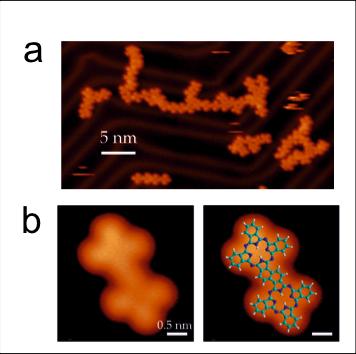

a) STM image displaying the formation of quasi-unidimensional polymers. b) STM image and models of the majority of products between coupled monomers.
Credit: Dr. David Ecija, IMDEA Nanoscience
Surface-mediated synthesis of low-dimensional polymers from simple molecular precursors is a rapidly emerging field. In this work, the researchers introduce surface-confined thermally tunable reaction pathways as a route to select intramolecular versus intermolecular reactions yielding either monomeric phthalocyanines or low-dimensional phthalocyanine polymers, respectively.
The precursor was designed and synthesised at ICIQ's laboratories. Next at IMDEA Nanoscience, it was deposited on a gold surface where it has been gently annealed to more than 300ºC in order to study its behaviour. When the temperature rises up to 275ºC, the polymerisation of the molecule occurs resulting in phthalocyanine unidimensional polymers (phthalocyanine tapes) that had not been synthesised so far.
However, if the molecules are deposited on a substrate held at 300ºC, the polymeric growth is blocked and the precursor is transformed into individual phthalocyanines. This selectivity induced by temperature, despite being a promising strategy for increasing the synthetic versatility, had not been used on surfaces up to now. Nevertheless, this use could have huge advantages when engineering nanostructures with technological applications.
“On-surface synthesis is a promising strategy for the formation of nanostructures. This new thermally controlled reaction presents a very interesting alternative for the development of new polymeric materials, which will satisfy the growing demand from disciplines such as nanotechnology, information technology and biotechnology” -say Prof. Galan-Mascaros and Dr. David Ecija.
###
Corresponding authors:
Pablo Ballester: pballester@iciq.es
José R. Galan-Mascaros: jrgalan@iciq.es
David Ecija: david.ecija@imdea.org
Ref:
Thermal selectivity of intermolecular versus intramolecular reactions on surfaces
B. Cirera, N. Giménez-Agulló, J. Björk, F. Martínez-Peña, A. Martin-jimenez, J. Rodríguez-Fernandez, A. M. Pizarro, R. Otero, J.M. Gallego, P. Ballester, J. R. Galan-Mascaros, D. Ecija Nature Communications, 2016, 7, 11002
About the Institute of Chemical Research of Catalonia:
The ICIQ is a member of the Barcelona Institute of Science and Technology and a leading international centre of chemical research. The institute has 19 research groups that work in the areas of catalysis (discovery and improvement of more sustainable chemical production processes and drug development) and renewable energies (generation of hydrogen from water, photovoltaic molecular, conversion of CO2 into materials and fuels of industrial interest). The ICIQ is a Centro de Excelencia Severo Ochoa, has received 14 grants from the European Research Council (ERC) and 9 of its researchers are ICREA professors.
About IMDEA Nanoscience:
IMDEA-Nanociencia is a private non profit Foundation created by initiative of the the regional Government of the Community of Madrid in November 2006 in order to shorten the distance between the research and society in the Madrid region and provide new capacity for research, technological development and innovation in the field of Nanoscience, Nanotechnology and Molecular Design. The Foundation manages the IMDEA-Nanociencia Institute, a new interdisciplinary research centre dedicated to the exploration of basic nanoscience and the development of applications of nanotechnology in connection with innovative industries.The IMDEA-Nanociencia Institute is part of one of the strategic lines of the Campus of International Excellence (CEI) UAM+CSIC.












